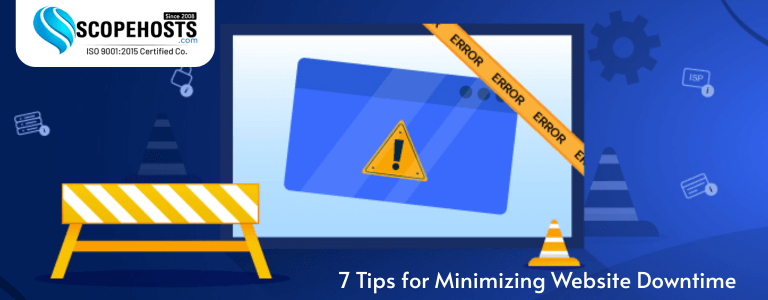Introduction: The Impact of Website Downtime
In today’s hyper-connected digital landscape, website availability is essential to business credibility and customer satisfaction. Website downtime, even if it lasts for only a few minutes, can lead to lost revenue, a damaged reputation, poor user experience, and decreased search ranking. As a result of a study completed by Gartner, the average cost of IT downtime is $5,600 per minute. For larger companies, this can lead to a large loss of income and customers.
Whether you run an e-commerce store, a blog, or a corporate site, minimizing website unavailability is critical. In this blog, we will share seven realistic tips to help reduce website downtime, and keep your online presence stable and trustworthy.

Tip 1: Choose a Reliable Hosting Provider
Your website’s foundation for uptime is your hosting provider. Never choose a host based solely on price. Choose a host that will look after the uptime, performance, security, and support. Criteria like uptime guarantee, server response time, and customer support are very important to prevent your website from going down.
Many hosts will have a robust infrastructure to support uptime with good quality service using SSDs, modern data centres, proactive maintenance systems, etc. For business-critical sites, especially e-commerce stores, the investment in managed hosting or a cloud solution is often worth the cost.
Tip 2: Implement Load Balancing
The risk of relying on a single server grows as your website’s traffic and complexity increase. Load balancing distributes incoming traffic across more than one server, so no one server carries the entire load.This helps performance during busy times, and also increases redundancy.
Utilizing load balancing means that if one server goes down, another can take over, and your service can be restored immediately. Cloud platforms like AWS, Google Cloud, and Azure all come with built-in load balancers, all of which are scalable and highly reliable. This approach significantly reduces the risk of downtime from server overload or failure.

Tip 3: Use a Content Delivery Network (CDN)
A Content Delivery Network (CDN) allows you to serve your website’s content from multiple locations across the globe. Instead of accessing the data from a single location, the CDN will serve the data from the server closest to the user. This speeds up the delivery for the end user and reduces the load on your origin server.
Critically, CDNs can buffer against high-traffic events or DDoS attacks, helping to keep your site online. CDNs also come with caching and failover systems so that your content can be accessible even if your primary server is down. Some reliable options are Cloudflare and Amazon CloudFront, both of which are easy to work with.
Tip 4: Regularly Monitor Your Website
Consistent monitoring helps you identify and resolve issues before they escalate into major incidents. Use monitoring tools to track essential metrics like uptime, server response times, and page load speed.. In addition, there are monitoring tools that will also monitor your website’s APIs, SSL Certificates, and transaction flows.
With instant alerts, your team can move quickly to address issues and mitigate an impact. Whether using free monitoring tools like Uptime Robot, or premium monitoring tools like New Relic or Pingdom, you should make monitoring your website an integral part of the ongoing maintenance process.
Tip 5: Optimize Website Performance
Consider a less metaphorical phrase: “A slow-loading website is a liability waiting to fail under pressure. An abundance of unoptimized images, scripts, and plugins can cause your site to lag under pressure and potentially crash. Optimization of site performance relieves pressure on your server, allowing your site to load faster, and continue to persist through problems.
Key areas for optimization include media compression, code minification, and caching. If using a CMS like WordPress, pay attention to the quantity and functionality of plugins. Use dizzy plugins, use swift themes, and strongly consider a performance plugin to take care of heavy lifting of optimization. An optimized site won’t just stay up longer, it will better the overall user experience.

Tip 6: Schedule Regular Backups and Updates
Failing to back up and update your site leaves you vulnerable to downtime from bugs, compatibility issues, or cyberattacks. Therefore, ensure your CMS, themes, and plugins are always updated to their most secure and stable versions.. Backups protect you when issues arise.
Setting up automated backups and ensuring they are really backed up—to preferably an offsite or cloud location-is critical. If your site goes down due to a faulty update or an attack, you can restore it from the most recent backup with minimal downtime.
Tip 7: Establish a Disaster Recovery Plan
Regardless of what precautions are taken, things can still go wrong. That’s why a disaster recovery (DR) plan is so important for a website owner, as it outlines how you would respond to your worst-case scenarios: crashed servers, security breaches, or an outage that affects many sites.
Your DR plan should identify responsible personnel, outline the steps to recover your site, and detail communication protocols for internal teams and users. The DR plan must be tested regularly to ensure it works as intended. Having a good recovery strategy may save you hours of costly downtime by reducing recovery time.
Conclusion
Reducing website downtime isn’t just about reacting to problems; it’s about building a resilient, reliable system. A robust plan—from selecting a trustworthy host to deploying load balancing, performance optimizations, and disaster recovery—is essential for keeping your site online. The steps outlined above are essential to keeping your website uptime high.
In a digital-first world, your website is typically the first—and sometimes only—touchpoint your audience has with your brand. By taking these preventative measures against downtime, you are preserving revenue and building credibility with your audiences and partners alike. Don’t wait for a major outage: strengthen your digital infrastructure now to ensure 24/7 operations.







